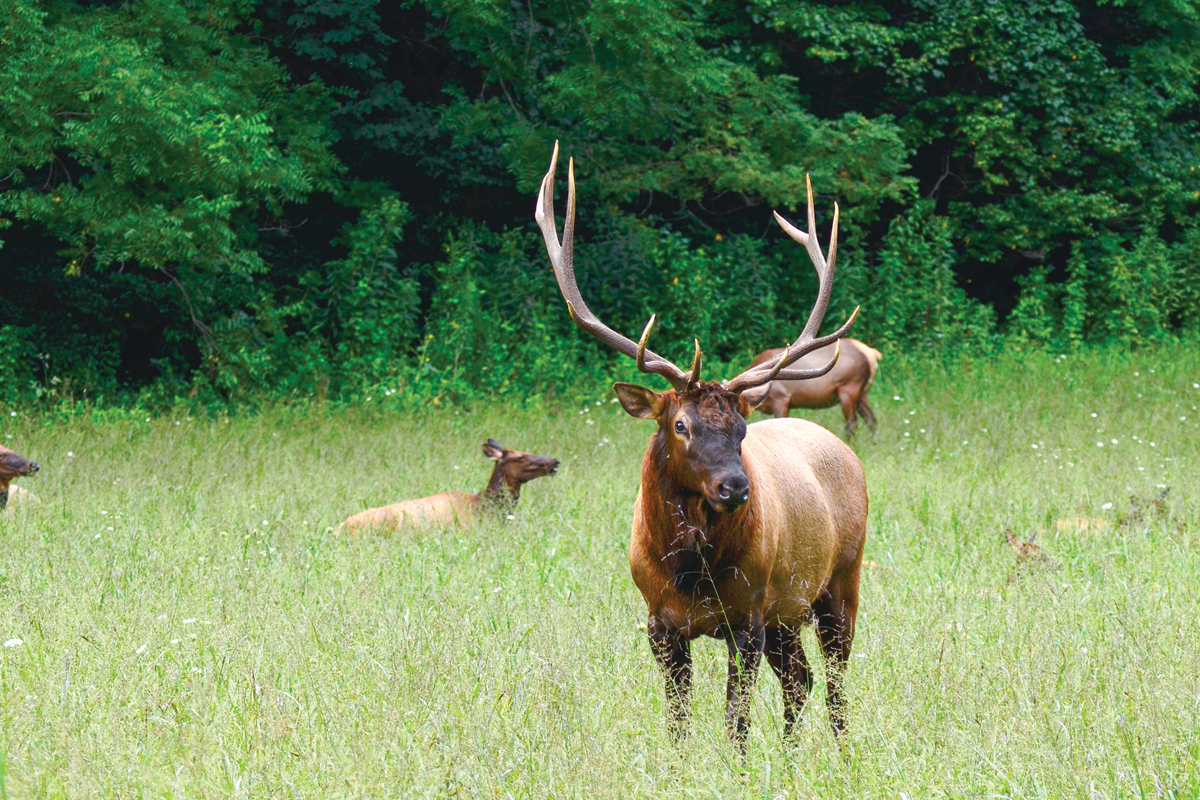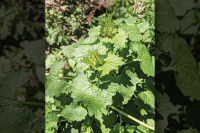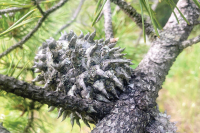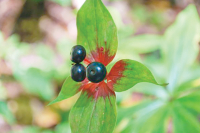Word from the Smokies: Dedicated Smokies volunteer force protects elk and people
 A bull elk stands amid a herd of about 30 elk grazing in a field near Couches Creek in the Oconaluftee area. Holly Kays photo
A bull elk stands amid a herd of about 30 elk grazing in a field near Couches Creek in the Oconaluftee area. Holly Kays photo
At 3:30 p.m., traffic flows smoothly along U.S. 441 past the Oconaluftee Visitor Center. The 80-some elk living in this area of Great Smoky Mountains National Park are still invisible beneath the forest canopy as the sun shines bright and warm.
But the group of volunteers gathering in the basement of the Oconaluftee administration building knows the calm won’t last. Amid the hellos and catch-up conversation about recent summer travels, they don bright yellow safety vests and gather radios and orange flags. They’re preparing for the inevitable moment when the elk will wander into the fields lining the park’s main thoroughfare, creating an impromptu roadside attraction.
It’s a situation that portends danger for elk and humans alike, and that’s why the Luftee Rovers, one of the park’s largest volunteer groups, was formed in 2012. With program costs covered by park funds and Friends of the Smokies donations, these volunteers patrol the Oconaluftee area every evening from May through the end of October, springing into action when the herd emerges. They react to ever-changing conditions, juggling a trio of competing priorities — traffic management, visitor management, and education.
“Traffic management is their primary role,” said Lauren LaRocca, law enforcement ranger and Luftee Rover program manager. “This ensures that people are staying safe while watching the elk and driving through the park, and that the elk are protected in the most natural environment they can be.”
Elk are both new and native to the Great Smokies. Overhunting eliminated them from the region in the 1800s, but since the species was reintroduced at Cataloochee in 2001, the herd has done well, its population more than quadrupling from 52 to an estimated 240. Since the Oconaluftee herd established itself, this area, already the park’s second-busiest entrance, has become an increasingly popular elk-watching destination. In 2023, 2.5 million visits originated there, about half a million more than when the Luftee Rover program launched in 2012.
“The more the herd and the visitation grow, the more you have to manage,” said Swain County resident Robert Triplett, one of seven Luftee Rover team leads.
Related Items

Robert Triplett, team lead for the Monday night volunteer Luftee Rover crew, coordinates with a team member as the Aug. 19 shift begins. Holly Kays photo
Triplett has worked Monday nights at Oconaluftee nearly every week for the past seven years. As team lead, he serves as the conduit for communication between LaRocca and the Monday night team, coordinating his fellow volunteers’ efforts during the shift. The group provides a valuable service, with the 38 Luftee Rovers who worked in 2023 contributing 3,921.3 hours valued at more than $131,000. With 53 volunteers in 2024, that number is expected to be even higher this year.
On this evening, Triplett sends pairs of volunteers in three different directions, riding the three-mile stretch of 441 from Cherokee to Smokemont Campground and the adjoining Job Corps Center loop, reporting any elk sightings into the radios they carry. It’s not long before the channel starts lighting up. A group of elk is grazing the fields near employee housing at the Job Corps Center, says one transmission. A few minutes later, another volunteer announces a large bull coming into the road near the maintenance building.
But by 4:30 p.m., nearly all the volunteers have converged at the field near Couches Creek, between Mingus Mill and Towstring. About 30 elk — cows, calves, and a couple bulls — have settled into the area. The gravel pull-offs along the road fill with cars, and traffic slows as drivers turn to see the animals.
In situations like this, the Luftee Rovers are critical to visitor safety. People exit their parked cars to get a better look at the animals, and many walk along the road or even try crossing it to approach the herd. Elk may seem docile, but they’re wild animals. If they feel threatened, they can become aggressive. With some males weighing as much as 1,000 pounds and carrying enormous racks of pointed antlers, an angry elk is capable of inflicting severe injury.
“Guys, you really need to stay behind your vehicles,” Luftee Rover Sharon Fish admonishes a family walking toward a better view of the bull across the road. “You’re really a little too close. Ma’am, he’s got a bead on you. You need to keep a vehicle between you and him for your safety.”
The group complies, retreating behind a nearby car. A friendly conversation commences as Fish congratulates them on coming on “a perfect day” and fills them in on what’s happening with the elk herd this time of year. The family is from Delaware, where elk don’t exist, and they seem appreciative of Fish’s knowledge.
“I don’t like to alarm people,” she says after they’ve gone, “but I don’t want them to be in danger either.”
This is Fish’s first year as a Luftee Rover, but it’s a role she’s long desired. During her career as a social worker at Jackson County Schools, she took her students to watch the reintroduction in 2001. Since then, she’s been “waiting for the opportunity” retirement afforded to get more involved.
I finish chatting with Fish and am ready to keep walking, but the massive bull on the other side of the road has just risen to his feet, contemplating a crossing. I stay where I am, behind a car. The elk steps forward, his enormous rack, six points on each antler, extending far above the roof of the burliest pickup truck. All along the road, heads crane out of windows and doors sit ajar as visitors aim their cameras toward him. The cows will probably follow when they realize he’s gone, says Fish. The bull evidently thinks so too. He lifts his head and gives out a single bugle — an ethereal, wild sound — and waits for his harem to come. When they don’t, he walks into the woods and begins ripping down saplings with his antlers.

Robert Triplett, team lead for the Monday night volunteer crew, shares his knowledge about elk with a young visitor. Holly Kays photo
“He may be frustrated now,” says Triplett, explaining the bull’s actions to a visitor. “I’d be frustrated too,” the man replies sympathetically.
That bull may find his efforts more productive in the coming weeks, as the rut begins. During their breeding season in September and October each year, the ungulates’ hormones go into overdrive, male elk bugling and sparring in an urgent quest for female attention. This coincides with one of the busiest seasons in the Smokies; October has been the highest-visitation month every year since the pandemic. Between leaf-lookers, wildlife watchers, regular park traffic, and people just wanting to pass through to Gatlinburg or Cherokee, traffic is sometimes backed up “as far as you can see,” said Triplett. Meanwhile, elevated hormone levels make the elk even less predictable than usual.
“To have the influx of visitation at the same time as the rise of hormones in these animals, it’s a very sensitive time,” said LaRocca, “and that’s why it’s so imperative that visitors listen to the volunteers. They’re there for their safety.”
The backed-up traffic can make people impatient, said Franklin resident Chris Cooper, who has volunteered with his wife Claire since 2014. That’s when they sometimes say unkind things or engage in “non-verbal communication” from their vehicles. But many people express gratitude. “They understand that we don’t get paid, that this is just something we do for fun, and they thank us for our time,” he said. Once, a pair of visitors even drove into town and brought back treats from Dairy Queen for Cooper and his wife.
Working just down the road from Fish is Liz Wilson, a retired probation parole officer. Of the many volunteer jobs she’s had in her life, this is one of her favorites.
“It’s outdoors, and it’s wildlife, and you meet all kinds of people that are generally just very excited about the elk,” she said.
For many volunteers, these interactions are what keep them coming back, year after year.

A bull elk crosses U.S. 441 at Couches Creek in the Oconaluftee area, causing traffic to come to a standstill. The volunteer Luftee Rovers work to ensure safety for both people and elk in such situations. Holly Kays photo
“The people are so curious, and I love that,” said Wilson. “If we can teach our people how important this park is, maybe they’ll understand that when they come through, they should enjoy it, but also take care of it.”
When viewing elk, stay out of the fields and always remain at least 50 yards away. If an animal changes its behavior in response to your presence, you’re too close. Do not feed elk or any other wild animals. Learn more about how to responsibly enjoy the elk at nps.gov/grsm/learn/nature/elk.htm.
(Holly Kays is the lead writer for the 29,000-member Smokies Life, a nonprofit dedicated to supporting the scientific, historical, and interpretive activities of Great Smoky Mountains National Park by providing educational products and services such as this column. Learn more at SmokiesLife.org or reach the author at This email address is being protected from spambots. You need JavaScript enabled to view it..)













